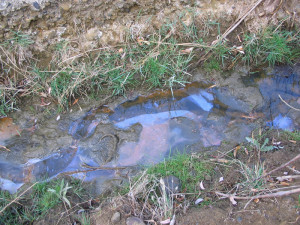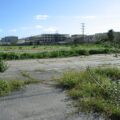
This September 15, 2010 e-mail Q & A was between reporter Michael Collins and, presumably, DTSC’s Runkle Canyon project manager Rick Brausch. The interview attempted to clarify a few points for the LA Weekly article “Rocketdyne Cleanup Won’t Help Runkle Canyon” published September 23.
[Question] 1. As we discussed, the decision to use the 1.7 picocuries per gram (pCi/g) of soil as the baseline level of strontium-90 (Sr-90) in Runkle Canyon soil designated as “elevated” came from “statistical analysis” as you put it. The EPA determined in 1995 that the background for Sr-90 in the area is 0.052 pCi/g. The Response Plan “elevated” level is about 33 times background.
The SSFL cleanup agreement dictates remediation to background levels yet the Runkle Canyon one is 33 times higher for Sr-90 in an area where people may live.
– Why are the Runkle Canyon Sr-90 levels 33 times higher than the lab’s mandated level?
– Why are there two standards for a contiguous piece of land with the more relaxed standard where people may live?
Response: The 1.7pCi/g was used not as an indicator of risk or to determine whether the reported levels of Sr-90 require action. Rather, it was used as a point of departure to establish those locations sampled previously which had the highest levels of Sr-90, and would be the most likely to be found to have elevated levels upon re-sampling. The primary purpose of the additional sampling was to provide some basis through which DTSC could evaluate the previous sampling efforts which yielded contradictory results. The contradictory results were the primary concern that formed the basis for many of the comments DTSC received.
Once issues related to data inconsistency and reliability have been addressed, DTSC will be in a position to interpret that data and compare it to relevant health and cleanup standards.
2. The Response Plan says that two surface water samples were taken and came back with heavy metal results similar to previous investigations yet then says there was no arsenic, nickel or chromium at all in the samples.
– How can reconcile this because the two previous investigations, by the Radiation Rangers and the City of Simi Valley, came back high in arsenic and nickel in Runkle Canyon Creek surface water?
– Could there be something wrong with the samples since all water in the area has arsenic in it?
– What were the actual lab results of the these two water samples?
Response: As described in our phone conversation in August, DTSC understands the concern you raise on the discrepancy of results, and is researching the sample results and analytical methods to determine if there is any explanation for the obvious differences between results presented for “split” samples. DTSC has not yet concluded this evaluation, and will make no final decisions or interpretations of the data until this issue is satisfactorily resolved. The actual lab sheets for the samples in question are attached.
3. The previous investigations tested for heavy metals in Runkle Canyon Creek soil and found high heavy metals including a reading of 34,000 [parts per billion] ppb for arsenic in one sample which is 9.7 times the State’s arithmetic mean. Yet there is no requirement in the Response Plan to test the creek soil.
– Why is there no requirement to investigate Runkle Canyon Creek soil contamination, contamination previously identified in two professional surveys and lab analysis?
– Why will SSFL’s soil be cleaned up to background for heavy metals yet Runkle Canyon’s heavy metal-impacted soil isn’t even investigated?
Response: Soil at the Runkle Canyon property has been investigated for metals concentrations, both prior to and after the sample with 34 mg/kg was collected. Since 1999 more than 50 samples have been analyzed for metals concentrations across the site. The other analytical testing did not indicate elevated arsenic concentrations. Six samples were collected at or around the location of the sample with 34 mg/kg attempting to replicate this concentration. Of those six, arsenic was detected in only four, and at concentrations ranging from 1.1 mg/kg to 7.3 mg/kg.
DTSC has not made any decisions related to the overall condition of the site.
4. DTSC received over 100 pages of comments, including our own, from several groups and individuals including residents.
– Why didn’t DTSC respond to these comments?
– Why wasn’t the community, particularily the people who commented, not informed of the Response Plan?
Response: DTSC evaluated the comments and found that many were not focused on the activities described in the Response Plan itself, but largely on the activities and issues that were not in the described responses, in the background and other information presented in the plan, which the commenters felt strongly needed to be addressed. The primary response to these overarching comments, which DTSC is not and has not dismissed, is to take steps to gather additional information to be able to interpret and understand the site conditions that are not well explained due to contradiction, or where conflict of interest concerns raise questions about the data itself.
As for DTSC’s failure to communicate with the commenters, this was not DTSC’s intent nor was it DTSC’s intent to withhold information. DTSC is currently sending responses to the commenters, albeit very late, and is planning to host a meeting with the commenters to discuss their concerns and DTSC’s goals in responding to the comments.
5. The topic of the Runkle Canyon Response Plan wasn’t put on this Thursday’s SSFL Workgroup agenda.
– Does DTSC consider its response to the community about this issue to be adequate and protective of its health and the environment?
Response: DTSC absolutely does not consider the topic closed nor that the community’s questions and concerns have been fully or adequately addressed (nor has DTSC made final decisions). As for the Workgroup agenda, the Workgroup decided to change the agenda because of the importance of the recently negotiated agreements with DOE and NASA and a desire to discuss the agreements instead. As stated above, DTSC intends to follow up with the commenters separately.
24 Years of Award-Winning SSFL/Rocketdyne Reporting
June 1998 – June 2022












Recent Comments